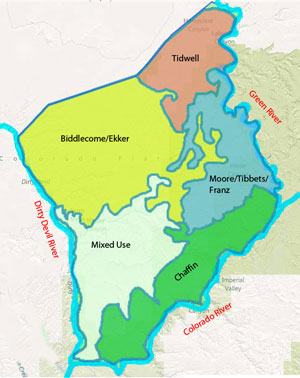Last summer saw the meteoric rise in sales of a new book on the last of the Robbers Roost outlaws from the 1920s, Bill Tibbetts. This summer marks completion of a monumental multi-agency task of documenting the cowboy days of Canyonlands, up to and beyond Tibbetts time and including Native American tales.
“It’s all part of a groundbreaking project initiated by the National Park Service that mostly focuses on subsistence ranching in the late 1800s through the 1940s in areas that are now parks in southeastern Utah”, said Gary Cox, a Canyonlands park ranger who is among original participants in the study."
Cox began conducting oral histories to capture untold tales of Canyonlands in 1986 as a volunteer, then hired on as a ranger for the Maze, where he intends to work until retirement. Cox focused on ten families that made an early living in the area, including the first family to offer tours into Canyonlands from Sleeping Rainbow Ranch -- the family of Lert Knee.
Cox figures he’s completed at least 15 oral histories, and clicks off names: Kent and Fern Frost, Ned 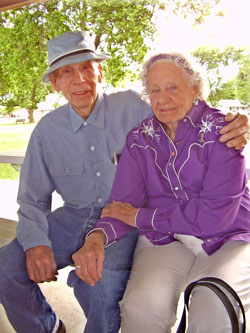 Chaffin, Bill Racey, Loren Milton, Bill Cunningham, Wiladeane Chaffin, Gaye Marie Ekker, Frank Tidwell, Lert Knee, and Ted Ekker. Chaffin, Bill Racey, Loren Milton, Bill Cunningham, Wiladeane Chaffin, Gaye Marie Ekker, Frank Tidwell, Lert Knee, and Ted Ekker.
Other important histories of early cattle ranching that are part of the research include Joe and Millie Biddlecome. Cox is seeking more information on the George Franz, and Eph Moore-Bill Tibbetts operations.
“I’m the guy working on this for years and years”, Cox said. His interest led to the meeting of two important characters in 1994 -- Ned Chaffin and Bill Racey -- which Cox calls the first Cowboy Caucus. That evolved into an annual reunion in Green River on the first Thursday after Memorial Day that draws descendants of the original ranching families of the area.
“I’m full of awe and respect for these people that came out here, especially in the early days, during the Depression and before, and tried to make a living in this really harsh environment -- this really super-rugged, harsh environment”, Cox said.
“I sort of came into the Park Service …as an environmentalist, and all the ranchers were the bad guys and the cowboys had destroyed the land and all that sort of thing, and I got to know these people and shifted my views pretty sharply in the direction of actually appreciating them for what they’d done -- admiring them for what they’d done”, he said. “They just barely scraped by, but back during the Depression if you did that, you were doing pretty good, I think”.
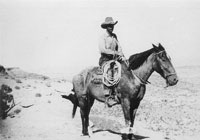
Cox and three others documenting human-history sites in Canyonlands National Park talked about the project, referred to as the Cultural Landscapes Initiative (CLI), by cell phone from the Maze District mid-June while heading to complete assessment of three final sites. All expressed appreciation for the kind of character and resilience cattle ranchers had to muster to sustain a living in the arid landscape. To walk the same trails and imagine the hard work of moving cattle around the area provides an historical perspective that blurs the stance that grazing was an unwise choice for making a living in the area, several agreed.
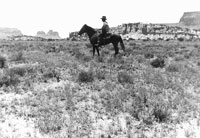
“It’s such an inhospitable place, and to imagine running cattle out here is almost unimaginable”, said Avana Andrade of Ft. Collins, Colo. Her role is to document ranching and grazing history in the Glen Canyon area, and she’s working with Navajo Indian elders to share historical accounts of livestock activity among the native tribes of southern Utah. While helping with field work in the Maze over the past few weeks, Andrade was struck by the craftsmanship of some of the early corrals -- how intricately and beautifully they blended into the landscape -- and she realized what an emotional connection to the land the early families must have had.
“I grew up taking backpacking trips in this area, and I’ve always loved it”, Andrade said, adding, “If anything, I’m thinking more like a rancher about this place, instead of like a naturalist or an environmentalist. It’s funny the way two months of an experience will change you. And this landscape -- this landscape changes people’s lives. It changes you in ways that I don’t think you can really describe, but it’s an amazing place and I’m kind of sad to leave it.”
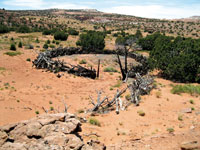 Paul Wackrow, the principal writer assigned to sum up the CLI, said “that the variance between how people perceive ranching practices from the past and the reality of those ranchers’ lives is an important part of the cultural study”. Paul Wackrow, the principal writer assigned to sum up the CLI, said “that the variance between how people perceive ranching practices from the past and the reality of those ranchers’ lives is an important part of the cultural study”.
“I think a lot of times when we read history and think about the big picture, we forget about the day-to-day lives of people that were doing these things”, said Joyce Evans of the Indian Rocks Ranch of Wyoming. Evans credits her involvement in the project the past six weeks with having the experience of being a fourth-generation rancher.
“We forget that those people were out here day-in and day-out in the heat and the cold and the wind and the gnats, and continued to make a living, and did it again the next year”, she said. “And we forget how hardy they were and how dedicated they were to what they were doing. I think it’s important to remember our history…and to realize that we are just a part of a continuum -- to realize what was possible then, and what’s possible now -- how things are connected”.
Besides cultural artifacts that Evans finds, such as little pieces of butter knives and camp boxes, the CLI collection will include photographs of early corrals and cabins, maps and drawings of trails and structures -- and last but not least, folklore about gold in the Henry Mountains, hidden caches and shortcuts along the Old Spanish Trail; indigenous accounts of sheepherding; documentation of more than 250 prehistoric archaeological sites; and tales of cattle rustling and rumored generosity of the Robin Hood of Robbers Roost, outlaw Butch Cassidy.
The project, yet to be formally named, is specific to the Canyonlands Maze District and the upper Glen Canyon National Recreation Area (Lake Powell), but also includes Hanksville and Green River, said Carrie Mardorf, CLI coordinator for the intermountain region of the National Park Service in Santa Fe, N.M.
Cultural inventories have been done previously in other parts of Canyonlands and Glen Canyon NRA, Mardorf said. But this CLI encompasses an unusually huge expanse of land covering more than 900 square miles, and includes participation of the federal offices from Richfield, Utah down to Page, Ariz. The major focus is on livestock operations in the Green River and San Rafael areas.
“It’s kind of groundbreaking in a way in how it involves multiple agencies”, Mardorf said. “It is kind of unique because it overlaps two park boundaries as well as BLM land”.
Cattle ranching, thieving and other types of human industry embarked upon to make a living in the pre-park days of southern Utah did not fall within well-defined boundaries; therefore, years of inventorying bled over the line into the most-recently designated national monument in Utah, the San Rafael Swell, and onto other neighboring lands managed by the U.S. Bureau of Land Management.
“Ultimately, the CLI project will involve the Utah State Department of History, which is required to sign off on the report before it is finalized”, Mardorf said.
“A report summarizing the efforts of the many people on the ground -- employed and voluntary -- and the findings from years of field work, oral histories, research of existing records and materials, photographs and accounts of the early days now told as family history by descendants, will be submitted as a draft document to the NPS in August”, said Paul Wackrow, a University of Vermont graduate who originally joined the Santa Fe staff as an intern in historic preservation. He was helping with the final work in the Land of Standing Rocks when he talked about his impressions and findings.
“This kind of differs from other types of documentation, like just documenting buildings and structures. It goes beyond that and looks at landscape features that might not normally be examined closely, like corrals and cabins, stock trails -- routes that cattlemen used to move their stock throughout the region -- changes in vegetation that would have occurred through grazing; basically any influence that any activity had on the land”, Wackrow said.
Being from Massachusetts, the intern had only read about the area and actually seeing it upon arrival in April altered his view of early cattle operations.
On horseback, this is a really massive landscape, and it’s quite an accomplishment that people -- ranchers -- were not only able to settle here but thrive here for so long. These ranchers loved the land, and it was a challenge, but these people were really up to it.
|
 Chaffin, Bill Racey, Loren Milton, Bill Cunningham, Wiladeane Chaffin, Gaye Marie Ekker, Frank Tidwell, Lert Knee, and Ted Ekker.
Chaffin, Bill Racey, Loren Milton, Bill Cunningham, Wiladeane Chaffin, Gaye Marie Ekker, Frank Tidwell, Lert Knee, and Ted Ekker.

 Paul Wackrow, the principal writer assigned to sum up the CLI, said “that the variance between how people perceive ranching practices from the past and the reality of those ranchers’ lives is an important part of the cultural study”.
Paul Wackrow, the principal writer assigned to sum up the CLI, said “that the variance between how people perceive ranching practices from the past and the reality of those ranchers’ lives is an important part of the cultural study”.